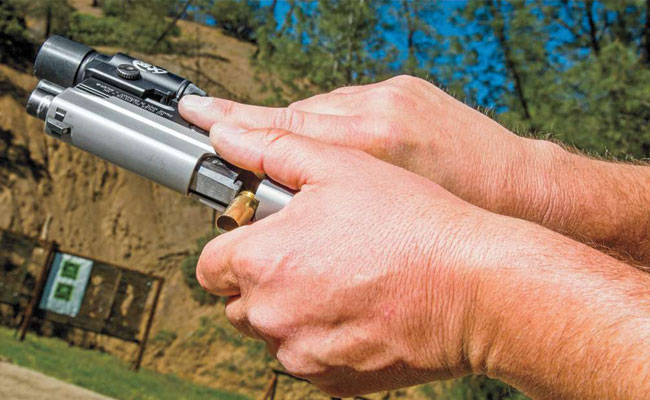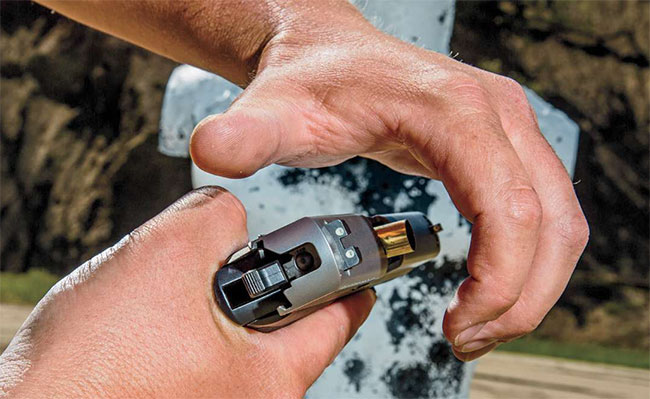A useful article for anyone who may need a refresher!
When your pistol malfunctions during a range session, do you stop and look at it, dumbfounded? Do you set your pistol down and raise your hand for assistance because you aren’t sure how to remedy the problem? These are common reactions for a new shooter, but if you’re going to carry a pistol or keep one in the home for defensive purposes, you need to be your gun’s emergency roadside mechanic. After all, lives may depend on your ability to fix your gun and get back in the fight.
When pressing the trigger of your pistol produces a “click” instead of a “bang,” it’s time to employ the immediate-action technique, also known as “tap, rack, assess.” There are a few ways to accomplish this, but they all share some common traits.
The first step to clearing most malfunctions is to release your grip with your non-dominant hand and use your palm to slam the bottom of the magazine. The rationale is that the malfunction may have been caused by the magazine not being fully seated in the magazine well. “Tapping” the magazine will help ensure it’s locked in place.

Although this is an important first step, merely tapping the magazine won’t enable you to fire the pistol. You need to cycle the action to ensure any obstruction in the chamber is cleared and a new round is fed.
To facilitate this, reach over the pistol and pinch the slide between your fingertips and the heel of your palm. Be sure to grip behind the eject port so your hand doesn’t block the ejection port and induce a double-feed stoppage.
Grip established, rack the slide forcefully to the rear. Racking the slide is easier with the momentum generated by a quick, aggressive cycling action. To ensure the slide travels completely rearward and therefore has the most spring tension to drive it back into battery, at the same time push forward on the grip with your dominant hand.
When you release the slide, allow your non-dominant hand to strike your chest to confirm you don’t ride the slide as it travels forward. Riding the slide decelerates the slide’s forward movement and could prevent the pistol from going back into battery. A popular tweak to this technique is to rotate the pistol to the right—toward the ejection port—so gravity will help clear the spent casings or bad rounds from the pistol.
After tapping the magazine and racking the slide, quickly assess the condition of your pistol and the threat. If you cant the pistol slightly to the left, you’ll be able to see if the slide is completely forward. If it is, your gun should be ready to fire.
At this point, it’s time to determine if firing your pistol is an appropriate response. Does the assailant still present an imminent deadly threat, or has he fled, taken a hostage or given up? Remember your response must be based on the current actions of the assailant. Just because he presented a deadly threat 10 seconds ago doesn’t mean it would be legally justified to shoot him now.
When I was a new police officer 20 years ago, we were taught to clear a malfunction while keeping the arm extended, with the pistol oriented to the threat. This was intended to prevent your adversary from recognizing your pistol was not operational. Also, since your muzzle was still pointed at the threat, it was considered faster to aim your pistol when the stoppage was remedied.
Today, most pistol instructors advocate keeping the gun close to the body while clearing a malfunction. After all, a seamstress doesn’t thread a needle with fully extended arms. Doing so would be quite frustrating and time-consuming. While sewing may not be an urgent endeavor, clearing a malfunctioned pistol certainly is.
In the modern version of the immediate-action technique, bring the gun toward your body and orient the magazine toward your non-dominant side. This positions it perfectly for a firm palm strike to the bottom of the magazine to ensure it’s fully seated.
Rather than racking the slide as described earlier, instructors like Dave Spaulding advocate a different technique. Rather than grip the slide with your fingertips and hand—thumb facing toward you—turn your hand over, thumb facing away.

Grip the slide with your thumb and as many fingertips as you can fit onto the slide. This is a more natural motion than gripping with your thumb facing toward you.
With this method, instead of rotating the pistol to the right—toward the ejection port—rotate the pistol to the left. This may seem counterproductive, but when you consider you are rotating the gun until the top of the slide is in about the seven o’clock position, it’s easy to see that gravity will still help clear the ejection port of spent casings or unfired rounds gumming up the works.
Again, rotating the pistol inward is more natural than rotating it outward. Many equate this to pouring out a beverage. You would almost certainly invert your cup by rotating it inward. It’s easier to turn the cup upside down this way. Your pistol is really no different.
Double Feeds
The immediate-action sequence won’t clear a double-feed. If you’ve already performed the…


